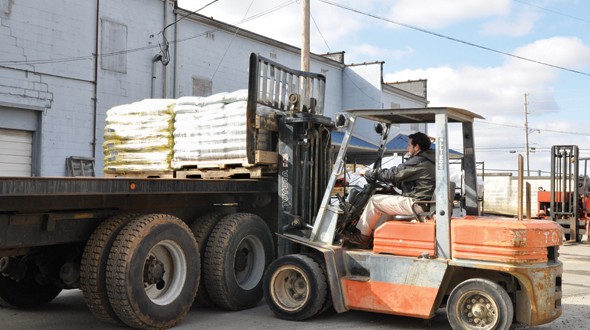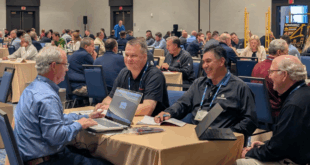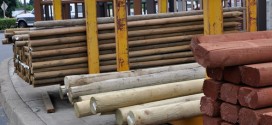Retailers can’t predict the future, but if they’re preparing for seasonal and inclement weather, they have to try. If they guess incorrectly, they might find the disruption in product delivery can be as catastrophic as the weather itself.
By looking back on one of the worst winters in years—a winter of drought and high temperatures for some and record snowfall and frigid temperatures for others—you can learn how to successfully juggle product procurement in unpredictable situations.
Reference Historic Data
When ordering seasonal items, it’s a good idea to reference orders and sales of seasonal items from past years, being careful not to follow them slavishly. Like many retailers, Brian Williams, manager of commercial and industrial sales at Leeper Hardware in Jefferson City, Tenn., uses regional weather patterns to guide
his purchasing, especially for the winter season.
Salt, something that was a slow mover in mild winters past, became the hottest commodity in his area last winter.
“Typically we buy three-quarters of the amount that we would sell, then refill from there,” says Williams, a third-generation retailer. “That would usually take us to the end of February.”
This past winter showed the method’s limited accuracy. As retailers across the South, Midwest and East were hit by snowstorms and ice on multiple occasions, the pre-booking many did for key seasonal products was woefully inadequate to keep up with demand.
“The weather gods don’t send us telegrams,” House-Hasson President Don Hasson says. “We play a lot of it by ear.”
Williams agrees, but he does everything he can to stay ahead of the weather. Knowing the forecast a few days in advance is helpful, so keeping up with long-term forecasts is a must.
“If I know a storm is coming a few days in advance, I can order salt, ice melt, shovels or sleds and get them delivered before it hits,” Williams says. “On the other hand, you have to be careful of what you buy. Sometimes you get bit because they say a storm is coming and it never does.”
Partner Closely with Suppliers
In order to fulfill the demand for key products during weather emergencies, retailers must work closely with their distributors. Many distributors offer lists or online resources that suggest the best products to have on hand, while others offer expedited ordering for those in emergency situations.
“True Value allows you to place emergency orders on its website,” says Wayne Averill of Ames True Value in Wiscasset, Maine. “We had
a 14-day stretch last Christmas with power outages, and we were able to get 11 trucks in that period.”
When Hurricane Sandy paralyzed the East Coast, Scott Pesavento of Hemlock Do it Best in Fairfield, Conn., leaned on his co-op for timely delivery.
“They accommodate you,” he says. “If you have an emergency order, they will get it to you. Luckily for us, our products were for an emergency, so the trucks were allowed on the road.”
Search for Scarce Products
Working with your distributor is key to getting product during bad weather—as long as the distributor can get that product in the first place. When snow and ice hit the Southeast last winter, the supply chain was unprepared for the demand for certain items.
Salt and ice melt became so scarce that Williams took to the telephone, contacting every supplier he could to locate those products.
“We were ahead of the game in that we had already pre-booked some salt right before the storm hit, and no one else did,” he says. Still, he spent days on the phone searching for more of it when supplies ran out.
Other scarce products were plastic pipefittings, pipe insulation and heat tape. Some products, namely heat tape, were sold out completely.
“The heat tapes are all imports, so we’re not able to restock them,” Hasson says. “Distributors order a certain inventory for the season and when it’s gone, it’s gone.”
Williams also used his position as an independent retailer to keep customers coming in the door. He contacted the local Lowe’s and Tractor Supply to find out if they had run out of salt or other high-demand products. If they had, Williams asked them to send their customers to him because he did have stock.
“The big-box stores didn’t have salt anymore,” he says, “and since they have little control of ordering at the store level, they weren’t going to get any more. So I asked them to send people looking for those products to me since I did have stock. I’ve tried to build a symbiotic relationship with my competitors, where they will send people to me if they don’t have a product and know that I do. It’s good business for them and for me.”
One For the Community
During emergencies of any kind, retailers are serving their communities, sometimes providing customers with basic necessities to weather the storm (think generators in a power outage). Being there and being open in such situations is powerful public relations.
When he hears bad weather’s on the way, Pesavento emails his town’s chief of police, city government officials and fire department to let them know his store is ready to help.
“It can be for anything weather-related,” he says. “Our first priority is the community. We work closely with the town to provide assistance—fans during heat waves, ice melt for the elderly—and help with cleanup when we can.”
Bad weather is just one time retailers help their communities, but they’re often the times people remember the most.
“It’s not only the sales you’re making, it’s how many people you can help,” Averill says.
From Here to There
If distributors and wholesalers don’t keep product moving and don’t get it on your shelves, everybody loses. That’s why they prepare in advance, training their drivers and using the best technology so their trucks get where they need to go, safely.
Dennis Shantz, director of fleet services for Canadian distributor Home Hardware Stores Ltd., has drivers who know how to handle inclement weather, especially snow and ice. Many of the retailers Home Hardware services are in remote or mountainous regions, where roads might not be plowed and snow lingers year-round.
“It’s challenging to deliver to stores in rural areas, and usually the rural highways are the first to be closed,” he says. “That’s due to open areas and blowing, drifting snow. We’ve had a few closures this year because of avalanches. All of our trucks have seasonal tires with deep treads, and all trucks in the Western provinces—which is mountainous—have snow chains for better grip.”
One way Home Hardware prepares drivers for these conditions is a mandatory defensive driving course, which is repeated every few years. Shantz says driving defensively is the key to safety, no matter the road conditions.
“The defensive driving course covers all aspects of safe driving, such as what can you do to avoid a collision,” he says. “We don’t want our drivers to become complacent. Statistics show that most collisions happen during the day when it’s clear
and dry.”
At the opposite extreme is House-Hasson, a distributor based in Knoxville, Tenn., where snow and ice aren’t as common. Their truck drivers, however, are trained extensively in safe driving and how to handle dangerous road conditions. The company’s fleet manager stays in touch with drivers, especially when weather can affect driving conditions. Both House-Hasson and Home Hardware have policies that require drivers to get off the roads if conditions get bad enough.
Bad Weather Best Practices
Distributors are dedicated to assisting retailers in making sales and keeping safe. Below are statements from several distributors about what how they prepare for weather emergencies.
Do it Best: “With today’s improved forecasting, many types of storm situations are more predictably anticipated, so there’s little reason to get caught off-guard without a ready supply products. In more spontaneous natural disasters, like wildfires, we provide our members a comprehensive list of emergency items they should have on hand or order quickly. In the midst of any disaster, staying in touch with your co-op is critically important so the flow of needed supplies is uninterrupted.”
Orgill: “The advice for the dealer is to have two plans—a pre-event plan and a post-event plan. They are very different and fluid because they are driven by the timing and severity of the event. Our sales reps are trained and given the tools they need to assist since they are our primary means of communicating with and helping our customers prepare for and recover from such events.”
Distribution America: “Distribution America distributors service customers in a variety of climates, each with their own unique weather-related issues. Each distributor has a plan in place to react to situations as they occur and provide guidance and support to their retailers as well.”
True Value: “Our strategy is to place orders for 75 to 80 percent of the anticipated needs of the season for winter products into regional distribution centers prior to Thanksgiving weekend. True Value watches the weather so we can enact our emergency response process prior to the arrival of inclement weather. The emergency response process enables retailers to make emergency orders, which can be quickly sent to them prior to a storm arriving True Value Retail Consultants, who work in in the field, will reach out to the affected retailers with advice and assistance to order prior to the storm.”
Ace: “Ace encourages retailers to anticipate customer demand by placing orders as early as possible, and often. As weather emergencies occur Ace quickly mobilizes a strong cross functional team from all key areas of the organization such as Merchandising, Supply Chain, Traffic, Retail Support and Inventory to address storm related demand. We have multiple conference calls daily as weather emergencies occur to assure all impacted areas are working to support our retailers.”
 Hardware Retailing The Industry's Source for Insights and Information
Hardware Retailing The Industry's Source for Insights and Information








